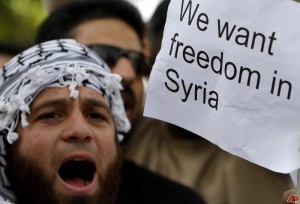
Spiralling violence took hold of the Syrian city of Homs on Tuesday as troops and militiamen loyal to President Bashar al-Assad killed 16 people in an apparent escalation of a security crackdown against a focal point for pro-democracy protests.
This brings the death toll in the country’s third biggest and most mixed city in the past few days alone to at least 40 people, in addition to an estimated 1,500 killed since the Syrian uprising began five months ago.
The latest fatalities added to mounting concern that events in Homs, which has a population of 1.5 million, are taking on a dangerously sectarian character.
In a grimly familiar pattern, Tuesday’s dead included three mourners at a funeral for 10 people who were killed by security forces on Monday, activists said.
“We could not bury the martyrs at the city’s main cemetery, so we opted for a smaller cemetery near the mosque when the militiamen began firing at us from their cars,” one mourner told Reuters. “We have to leave, we can’t stay – it’s too dangerous,” another resident told the Guardian.
Bodies were taken to a mosque in the eastern Khalidiya district, which is dominated by Sunni tribes, while an adjacent neighbourhood is home to many security forces personnel from the Assad family’s minority Alawi sect.
Rami Abdulrahman, director of the London-based Syrian Observatory for Human Rights, said Homs had seen intense battles since security forces stepped up a crackdown on Monday. Fighting erupted after three regime supporters who were kidnapped last week were killed and their dismembered bodies returned to their relatives. “These clashes are a dangerous development that undermines the revolution and serves the interests of its enemies who want it to turn into a civil war,” Abdulrahman said.
Another Homs resident said: “There are troops and armoured vehicles in every neighbourhood. The irregular forces with them are death squads. They have been firing indiscriminately since dawn with rifles and machine guns. No one can leave their homes.”
The Syrian authorities have expelled most foreign journalists from the country, making it hard to verify either witness accounts or official statements.
Troops and tanks first entered and occupied Homs, 100 miles north of Damascus, two months ago after protests demanding freedoms and the fall of the Assad regime. But the military has failed to quell the unrest, which has spread to almost every neighbourhood.
Some residents have admitted they are now fighting back after losing relatives or having their homes raided. Many claim that pro-government gangs of Alawis from surrounding villages have been threatening people and fuelling tensions. Homs, hometown of Assad’s Sunni wife Asma, has seen an influx of Alawis in recent years as the minority tightened its hold on security and other public sector jobs.
Residents in Homs and the coastal cities of Latakia, Banias and Jableh have reported Alawis being armed by the regime and armed gangs known as shabiha (ghosts) roaming the streets and helping to crush protests.
The use of these groups has increased the propensity for violent conflict and sectarianism as Syria’s protests enter their fifth month. Many Homs residents have armed themselves with guns and homemade molotov cocktails after warning that the regime’s crackdown could lead to wider violence.
Pro-democracy activists say they are struggling to deal with conflicting accounts of what is happening, while stressing the need to keep the uprising peaceful and non-sectarian.
Members of the network of local co-ordinating committees have claimed that sectarianism is being deliberately stoked by the regime.
Analysts warned that the violence and reports of sectarian tensions should not be overplayed while admitting that the Homs situation is potentially explosive. “It is really worrying,” said one dissident in the capital. “There are growing problems. But the violence is regime-provoked and we shouldn’t take this to mean there will be a civil war.”
Leave a Reply
You must be logged in to post a comment.